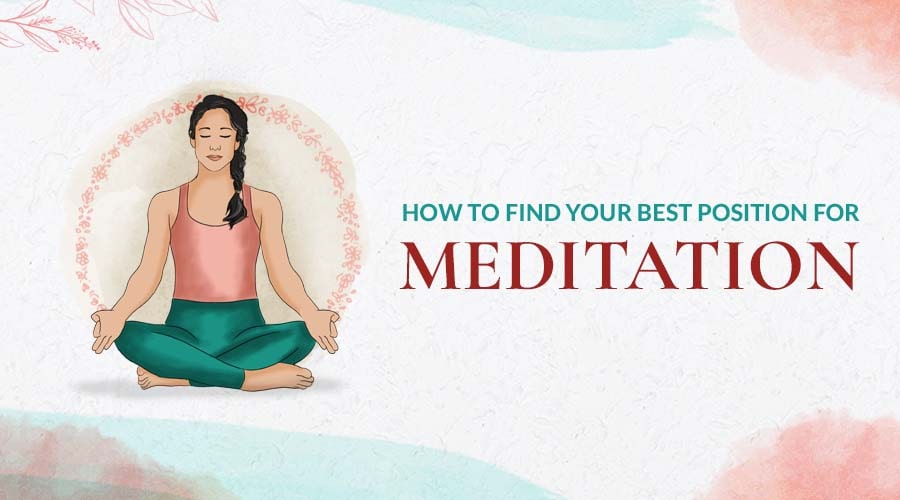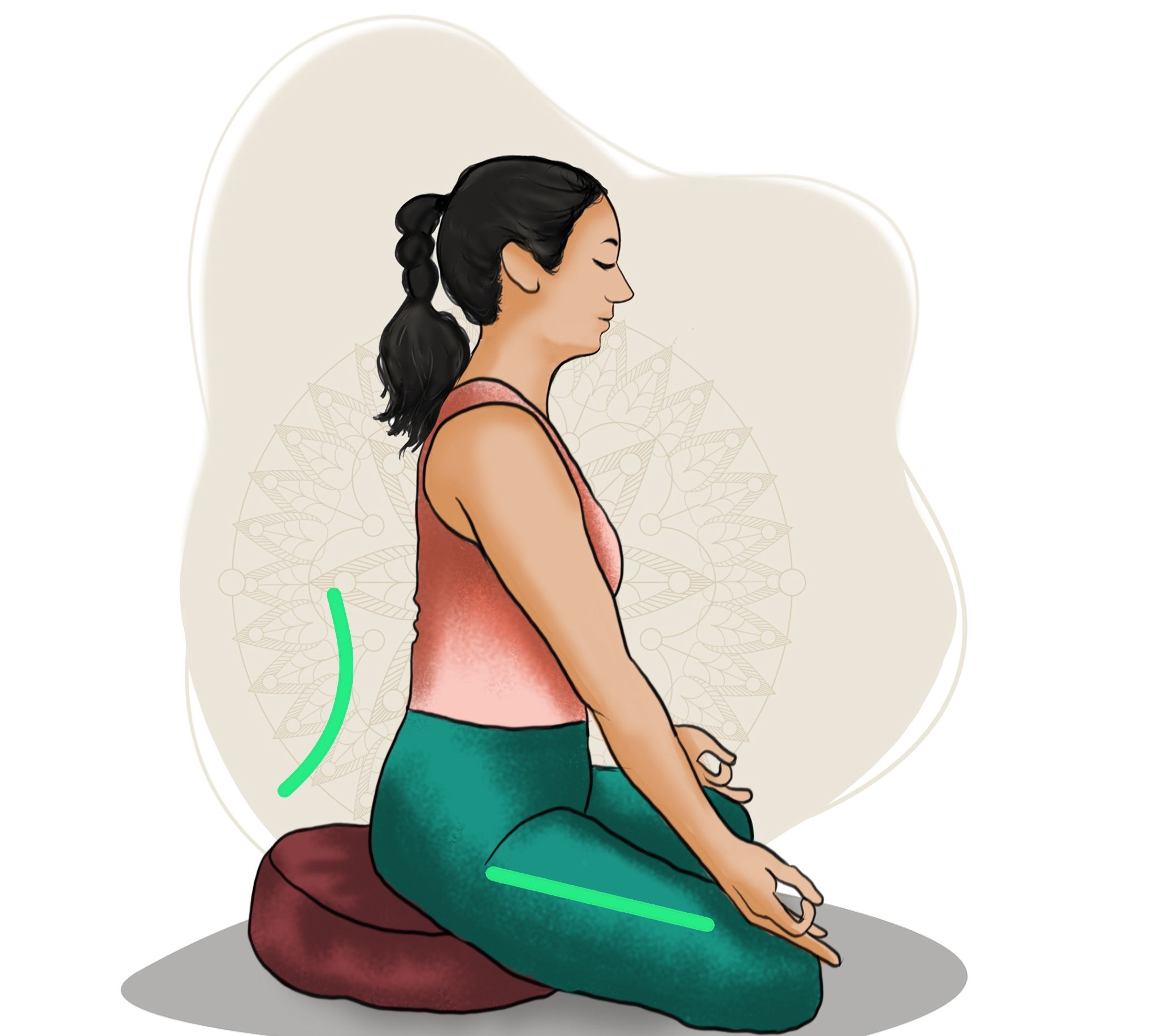Sitting is a part of daily life; you may find yourself in front of your laptop, or on the sofa watching television or reading a book. Sitting steadily for a considerable period is easier if we are preoccupied with distractions. For example, we can go to the cinema and watch a movie or sit at a luncheon with friends with little or no bodily discomfort. However, when we have to turn inward during meditation, sitting can be quite uncomfortable and we may struggle to find steadiness. We become discouraged. What if we could uncover the means allowing us to progress in our meditation practice using the right support and understanding how the body works in a sitting position. Read on further to discover what is required for a comfortable steady seat and how you can achieve it during your meditation practice!
Why the Right Position for Meditation Matters?
This is such an important question for practitioners as we somehow believe that being cross-legged, or in Lotus Pose is the right position for meditation. We see typical images of Sages from India in Lotus Pose on the floor or on social media of yogis in a cross-legged position with no props looking serene.
The truth is, we need to find a functional position during meditation. After all, the position we choose can make or break our meditation practice. Ideally, a sitting position will help us switch off from external stimuli and turn our attention inward during our meditation practice. To help us make an informed decision, we need to have some idea of what is going on anatomically so that we can learn about the natural alignment of the body and how to safely achieve it. This also helps us resolve undue stress and strain on the spine, knees, and muscles. We can then maintain a comfortable and steady seat for a longer period of time.
Maintaining the Integrity of the Spine in Meditation
It is easier to find natural alignment whilst standing because we have spent many years walking. Over time we have learned to use oppositional force; to press into the ground with the feet and reach the crown upwards. Walking has become automatic; in that, we can do it without even really thinking about it.
So, how do we find the right or natural alignment of the body during meditation? Well, when we are seated, it becomes more challenging to apply oppositional force. However, with practice, we most definitely can. Using this force will allow you to sit in a way that requires minimal effort. All we have to learn to do is generate an oppositional force using the spine and pelvis. Doing this respects the natural curvature of the spine.
You may hear cues in a yoga class asking to keep your spine straight. This is actually counter-productive for a healthy sitting position. The spine is a double S-shaped curve. When we attempt to straighten the spine, we then lose the natural curvature of the spine which is far from ideal. We need to sit in a way that supports and maintains the curvature of the spine. This will help us sit comfortably for long periods.
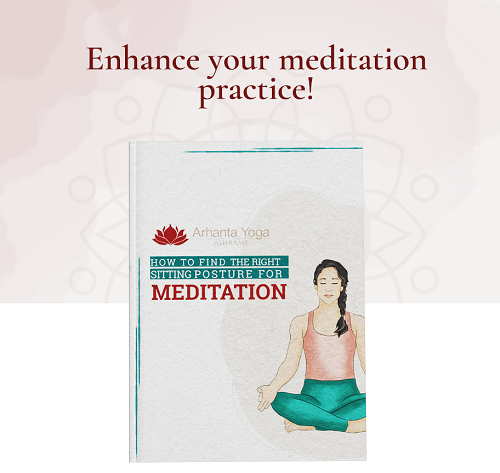
Get your free copy of the how to find the most comfortable sitting position for meditation Ebook
The Mind-Body Connection in Meditation
“When the body moves, so does the mind. When the body is disturbed, so is the mind.”
When there is incorrect pelvic alignment, we begin to engage unnecessary muscle groups to keep ourselves upright. This creates physical discomfort and contributes to moving around and fidgeting. If the body is moving around, this will be expressed in the mind. Such disturbances won’t allow us to keep a calm mind for meditation.
In yoga, the concept of Dharana, concentration is the 6th limb of the eight-limbed path. In meditation, we practice Dharana. We concentrate on the breath, an object, or a mantra. The mind-body connection is maintained through Dharana if we can find the best position for meditation.
Read on to find out more about yoga philosophy: "What are the Eight Limbs of Yoga?"
How to Find the Best Position for Meditation
Hip mobility in meditation
In a standing position, we have easier access to our mobility and our base, our pelvic alignment. For example, we don’t need to flex in the pelvis or eternally rotate the legs when standing. However, in a seated position we have our legs out and toward the floor. The legs are connected to the pelvis and so, the position of the pelvis changes.
Ideally, we want to sit on our ‘sitting-bones’ however, if there is lesser mobility in the hamstrings and glutes, we end up sitting on the tailbone. We then lose the natural curve in the lumbar spine. How do we fix this? Unfortunately, we are usually prompted to use a top-down approach to fixing our alignment. We follow cues that prompt us to keep the neck long, the shoulders down, and the chest out. These cues fail in creating the correct pelvic alignment needed for sitting in a healthy way.
In using a top-down approach to natural alignment, we also engage unnecessary muscles to hold us in the meditation position. We can strain the back and our concentration is disturbed. If we correct the pelvic alignment, we then correct spinal alignment and this effectively remedies the issues we face in the middle and upper back as well as the shoulders, neck, and head.
Instead, we need a bottom-up approach to spinal alignment because it is a pelvic alignment that maintains the curvature of the spine. This allows us to sit in meditation comfortably, steadily, and for a longer period of time.
To help us keep the correct pelvic alignment in a cross-legged position, we can assist the external rotation of the hip joint by sitting our pelvis higher. The aim is to have the pelvis higher than our knees. This can be challenging when the upper leg has to rotate to be in a cross-legged seated position. When we sit on a prop for support, lesser rotation of the leg in the hip socket is needed. By just sitting a little higher, the pelvis is above the knees, and this allows for an anterior pelvic tilt. Meditation in a supported cross-legged position thereby becomes more accessible.
When we have the correct alignment of the pelvis and a stable foundation in the base, we can train ourselves to maintain opposition to sit for longer periods. We can practice pushing down through the base and lengthening through the spine. Your upper body “hangs” off the spine which means lesser engagement of muscles to keep us sitting up.
The Relationship Between the Pelvis and Knees in Meditation
It is important that the pelvis is above the knees however they should not dangle above the floor. The knees should always be resting either on the floor or on appropriate support. When the knees are above the pelvis, we lose the curve in the lumbar spine, engage unnecessary muscles groups, and belly breathing is affected.
If a cross-legged position is not safely achievable right now, there is another option. You can try Vajrasana, aka Diamond Pose. You can place a cushion underneath the pelvis in this position. It is an easier way to access an elongated spine. In this position, make sure that your shoulders are over the pelvis. You can also roll a blanket and place it under your ankles to help your feet relax. If you experience knee pain, make sure you avoid leaning forward and you can place two cushions underneath your pelvis to create even more height. This is a safer pose for those that struggle with knee issues as the knees don’t have to flex that much and there is no danger for the knees to rotate. For more support, as you will be seated for an extended period of time, you can also roll a blanket and place it at the back of the knees.
Find out more about keeping your knees safe: "How to Avoid Knee Pain & Injury in Yoga for Sensitive Knees"
The Importance of Using Props for Meditation
The aim of finding the best position for meditation is that your body is still and undisturbed. In turn, you can then practice concentration where the mind is still and undisturbed. As the mind wanders, you can bring it back to the present time. A comfortable steady seat supports this practice of gently bringing the mind back. The most important thing to remember when finding your best position is that we are sitting actively.
Props are used to support us to sit actively in ways our anatomy is supported. However, we have to choose the right prop for the particular anatomical challenge. A towel or blanket is a great yoga prop as you can adjust the thickness quite easily. You can use it in various ways as explained above, for the knees and ankles.
You require a difference in the level between the pelvis and knees so that an anterior pelvic tilt is encouraged. You can also use a cushion to sit on to create this difference, just be sure to sit at the front edge of the cushion and choose a cushion that is not too thick. If the cushion raises your knees above the pelvis, then it is too thick. We tend to see students resting their knees on yoga blocks in a cross-leg position, Sukhasana. However, this raises the knees above the pelvis and the anterior pelvis tilt is lost. This will cause a strain on the back. If the prop straightens the spine or causes the spine to round or hollow out too much, it is a sign that the prop is not being used correctly.
If you need support for the back, you can use a yoga block in between your middle back and a wall or chair. This allows support so as to avoid slouching so you can sit actively.
A natural curve in the lower spine, the pelvis above the knees, and the knees being supported are signs we are using props correctly.
Anatomy of Meditation Poses
Sukhasana - Easy Cross-Legged Pose
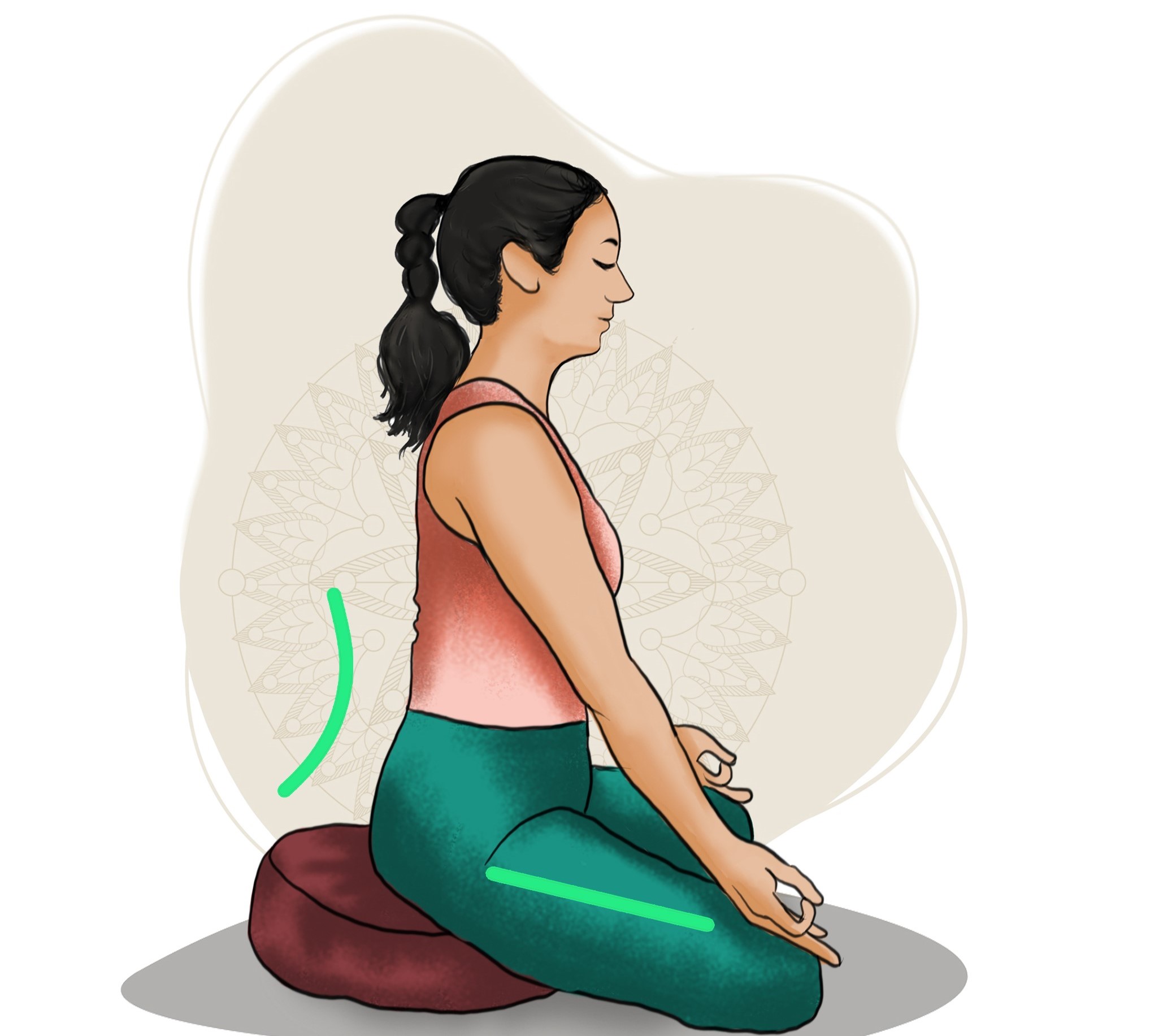
This is an option for those that have considerable mobility in the hip joints.
The knees are lower than the pelvis to allow for an anterior pelvic tilt. Practice sitting in Sukhasana as long as you are on sitting bones to help maintain the natural curve in the lumbar spine. If the knees are higher than the pelvis, the pelvis tucks under and we lose the curve in the lumbar spine. We then strain the lower back muscles. Most people should use a cushion under the pelvis. It shouldn’t be too thick though so that the knees can still rest comfortably on the floor. It is not uncommon to experience knee issues in yoga.
Vajrasana - Diamond Pose
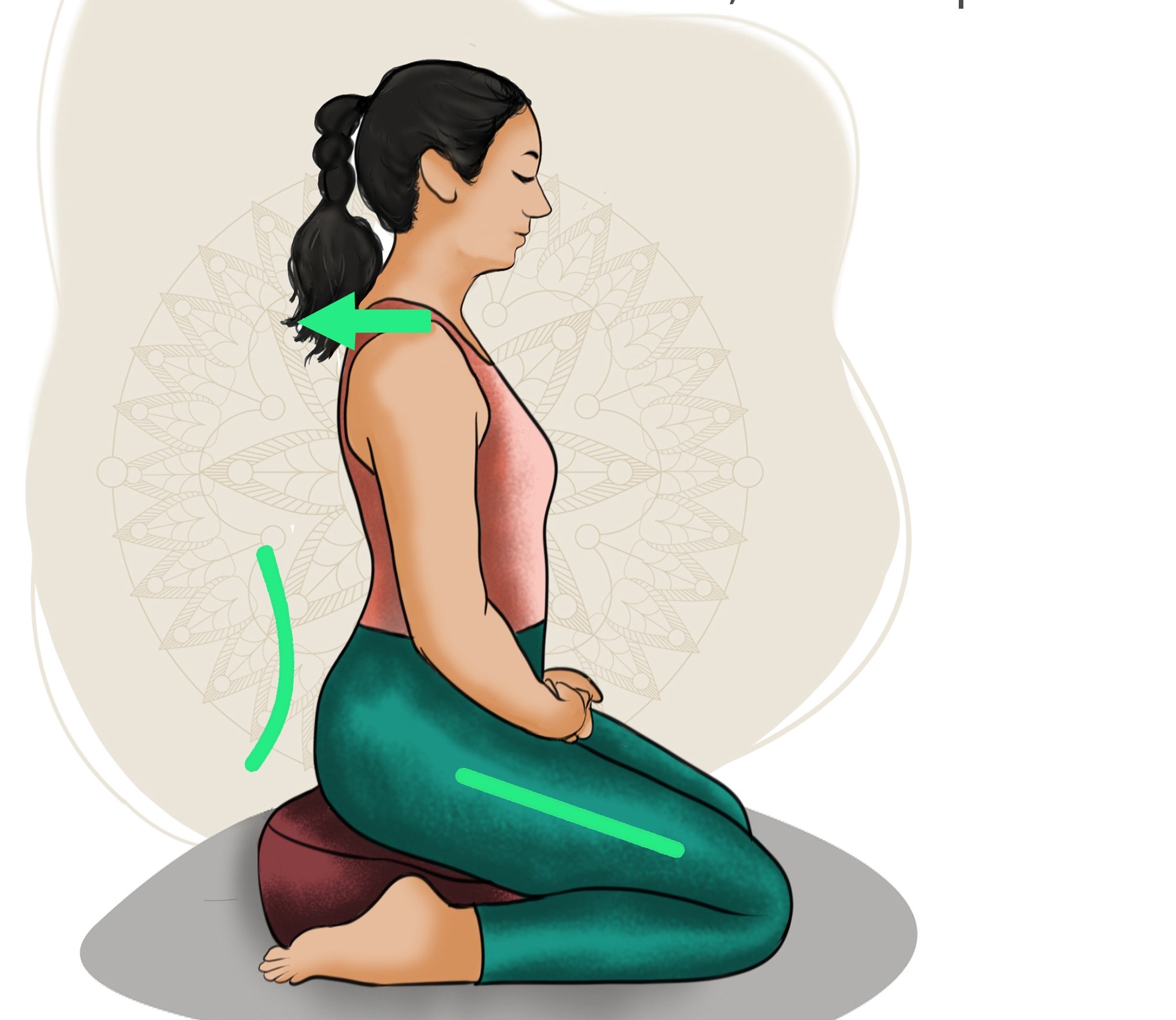
This position is great for those getting comfortable being seated on the floor. Remember to use the right support to help you sit for a longer period of time. If flexing your knees is not accessible, you can use multiple cushions to ‘prop yourself up' higher and reduce strain on the knees.
The knees are lower than the pelvis which allows for an anterior pelvic tilt. This allows for the curve in the lumbar spine to remain present and for us to be sitting on the sits-bones. This bottom-up approach to pelvic alignment naturally allows for shoulders to draw back and the chest to open. This is an active sitting position so be sure to elongate the spine and keep the hands at the top of the thighs. This helps avoid slouching forward in this position as the chest will collapse and belly breathing will be compromised.
Sitting on a Chair
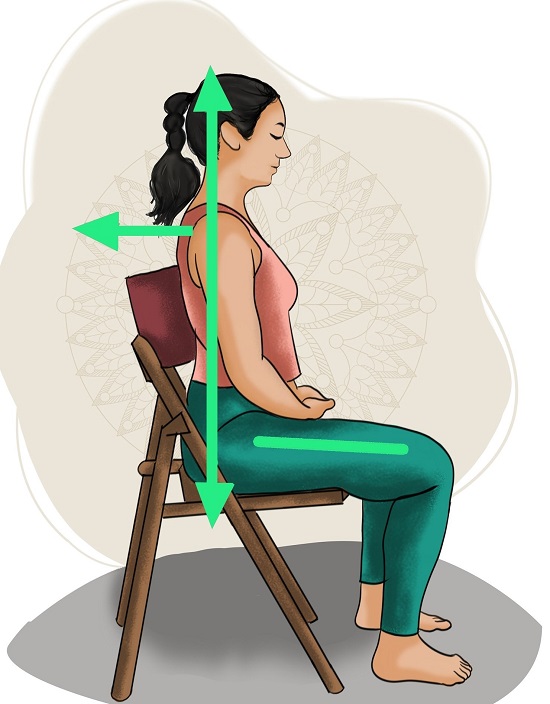
If sitting on the floor is inaccessible to you, you can still sit actively on a chair.
You can sit either at the edge of the chair or toward the back of the chair using the back support. You can sit on support to slightly elevate the pelvis, so it is above the knees. This helps ensure an anterior pelvic tilt. This helps the spine elongate which helps draw the shoulders down and then open the chest.
Dos and Don’ts in Meditation
How to Achieve Active Sitting in Meditation?
Remember, meditation is an active practice. Although we are still and seemingly undisturbed in meditation, we are intentionally concentrating on an object, the breath, or a mantra. We are keeping a particular posture to facilitate meditation and it is important that we cultivate a relaxed concentration in our body and mind. Meditation should not be practiced lying down or sitting against a wall for the simple reason that we may become inactive in posture and mind. We may even fall off to sleep! Try the positions above to find a seat that allows for active sitting and uses props.
Breathing Correctly During Meditation
During meditation, you want to make use of relaxed belly breathing. This means that the main facilitator for breathing should be your diaphragm. If we are sitting inactively, our belly and chest may collapse, and it becomes difficult to breathe diaphragmatically.
Feeling stressed? Try these 3 Yogic Breathing Techniques to Calm Down
Conclusion
Remember that we have to practice sitting correctly and this will take time. This is your meditation practice, paced according to where you are anatomically and where you are in mind. There must be a balance of effort and patience in this process to avoid frustrating yourself. As you continue in your practice, you will find gradual progress allowing you to sit more comfortably and steadily.

Get your free copy of the how to find the most comfortable sitting position for meditation Ebook

